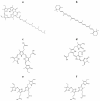Diversity of Bioactive Compounds in Microalgae: Key Classes and Functional Applications
- PMID: 40559631
- PMCID: PMC12194743
- DOI: 10.3390/md23060222
Diversity of Bioactive Compounds in Microalgae: Key Classes and Functional Applications
Abstract
Microalgae offer a sustainable and versatile source of bioactive compounds. Their rapid growth, efficient CO2 utilization, and adaptability make them a promising alternative to traditional production methods. Key compounds, such as proteins, polyunsaturated fatty acids (PUFAs), polyphenols, phytosterols, pigments, and mycosporine-like amino acids (MAAs), hold significant commercial value and are widely utilized in food, nutraceuticals, cosmetics, and pharmaceuticals, driving innovation across multiple industries. Their antiviral and enzyme-producing capabilities further enhance industrial and medical applications. Additionally, microalgae-based biostimulants and plant elicitor peptides (PEPs) contribute to sustainable agriculture by enhancing plant growth and resilience to environmental stressors. The GRAS status of several species facilitates market integration, but challenges in scaling and cost reduction remain. Advances in biotechnology and metabolic engineering will optimize production, driving growth in the global microalgae industry. With increasing consumer demand for natural, eco-friendly products, microalgae will play a vital role in health, food security, and environmental sustainability.
Keywords: biomass; carbon dioxide utilization; cosmeceuticals; food supplements; pharmaceuticals.
Conflict of interest statement
Luka Dobrovic was employed by the company Particula group Ltd.; Meropi Tsaousi was employed by the company Freshline Cosmetics; Alexandre M. C. Rodrigues, Catarina Anjos and Inês F. Costa were employed by the company Necton S.A.; Helena Cardoso and Rita Pires were employed by the company Allmicroalgae-Natural Products S.A.; Daniel Figueiredo was employed by the com-pany GreenCoLab—Associação Oceano Verde. The remaining authors declare that the research was conducted in the absence of any commercial or financial relationships that could be construed as a potential conflict of interest.
Figures









References
-
- Inam A., Oncu-Oner T., Deniz I. Cell Biology and Translational Medicine. Springer; Cham, Switzerland: 2024. Algae in Biomedicine. - PubMed
-
- Ma M., Hu Q. Microalgae as feed sources and feed additives for sustainable aquaculture: Prospects and challenges. Rev. Aquac. 2024;16:818–835. doi: 10.1111/raq.12869. - DOI
Publication types
MeSH terms
Substances
Grants and funding
LinkOut - more resources
Full Text Sources
Research Materials

